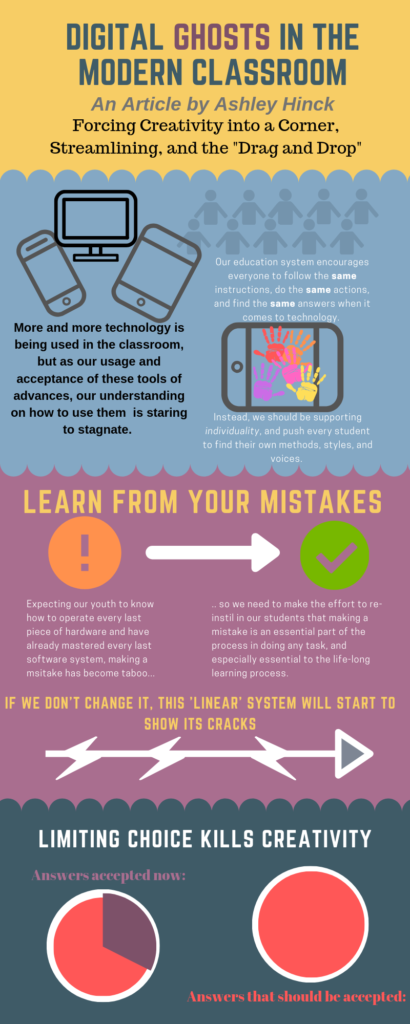Enthralled by Ashley Hinck’s article “Digital Ghosts in the Modern Classroom”, all about the institutional barriers set against students’ intuition and agency that only increased with our technological development, I set about writing my first multimedia reflection and blog post in reflection to that. To break up the monotony of text, I also opted to include an infographic. Lacking the hands-on artistic vision of my more creative colleagues, an infographic, when supported by the right software provider, can be easy to create and present information effectively, coupling them with just the right visuals, images, colours, and more to pass on a lesson in one of the best ways possible. I chose to work with Canva.
Hinck focuses on the fact that the education system is ushering in a series of “template sites or services”, where student usage of technology is becoming analogous to worker bees: press this button now, mirror each other’s actions, find the same answer (essentially the “drag and drop” concept Hinck repeatedly draws attention to). While there is certainly something to be said for efficiency and streamlining, it is coming at a cost of individuality and expressive freedom, with students now feeling like they can’t or shouldn’t step beyond the set paths.

As the students of today and tomorrow continue to be steered away from the trial and error system, we collectively seem to forget one of life’s best lessons: you learn from your mistakes. With our education systems using technology and digital software to the extent that it is, a pattern set to climb with every passing year, it’s simultaneously making erroneous moves a taboo thing. It doesn’t help that the software we use or the tech pieces everyone has access to have increasingly sophisticated tutorials, how-tos, and walkthroughs directing us on how to operate what we’re using, all to the point where it’s expected for anyone under the age of twenty to have the technical mastery of a graduated IT worker. From a generational theory perspective, these kinds of expectations have become burdening pressures: if you’re a young person, you should know how to use this stuff, and if you don’t know, then you must be some sort of social pariah.
In the English language, there are several different words for “hello”, but there are millions of ways to greet someone with a hello. Instead of limiting the pool of correct answers on how to use and what to do with our software and technology to the one-word “heys” and “his”, we should be much more open to accepting different styles and answers, whether it be another way to phrase it, like “good morning” or “how’s it going”, or another way to do it, like the handshake or high-five. We need to let students come up with different ways to do the same thing, and not throttle the correct answers to a predetermined answer-key. While these concepts can be applied across the teaching spectrum, it is especially important to apply it to classroom uses of technology. Everyone should be on the same page, and no one should be left behind. With choice comes creativity, and limiting the former completely snuffs out the latter.
